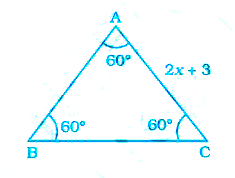Length of a side of an equilateral triangle and its perimeter vary inversely with each other.
To solve the problem, we need to analyze the relationship between the length of a side of an equilateral triangle and its perimeter.
1. Understanding the Properties of an Equilateral Triangle:
An equilateral triangle has all three sides equal in length. Let's denote the length of one side as A.
2. Calculating the Perimeter:
The perimeter P of an equilateral triangle can be calculated using the formula:
P=3×A
This means that if the length of a side increases, the perimeter will also increase.
3. Analyzing the Relationship:
The statement claims that the length of a side and the perimeter vary inversely. However, from our calculation, we see that as the side length A increases, the perimeter P also increases. This indicates a direct relationship, not an inverse one.
4. Conclusion:
Therefore, we conclude that the length of a side of an equilateral triangle and its perimeter vary directly with each other, not inversely. The original statement is false.
An equilateral triangle has all three sides equal in length. Let's denote the length of one side as A.
The perimeter P of an equilateral triangle can be calculated using the formula:
P=3×A
This means that if the length of a side increases, the perimeter will also increase.
The statement claims that the length of a side and the perimeter vary inversely. However, from our calculation, we see that as the side length A increases, the perimeter P also increases. This indicates a direct relationship, not an inverse one.
Therefore, we conclude that the length of a side of an equilateral triangle and its perimeter vary directly with each other, not inversely. The original statement is false.
Topper's Solved these Questions
- DIRECT AND INVERSE PROPORTIONS BOOK - NCERT EXEMPLARCHAPTER - DIRECT AND INVERSE PROPORTIONS EXERCISE - THINK AND DISCUSS
2 Videos
- DIRECT AND INVERSE PROPORTIONS BOOK - NCERT EXEMPLARCHAPTER - DIRECT AND INVERSE PROPORTIONS EXERCISE - THINK AND DISCUSS
2 Videos
- DATA HANDLINGBOOK - NCERT EXEMPLARCHAPTER - DATA HANDLINGEXERCISE - EXERCISE
73 Videos
- EXPONENTS AND POWERSBOOK - NCERT EXEMPLARCHAPTER - EXPONENTS AND POWERSEXERCISE - EXERCISE
195 Videos
Similar Questions
Knowledge Check
Each side of an equilateral triangle is 8 cm. Its area is
A16√3cm2B32√3cm2C24√3cm2D8√3cm2Each side of an equilateral triangle is 8 cm . Its area is
A24cm2B24√3cm2C16√3cm2D8√3cm2Each side of an equilateral triangle is 8 cm long. Its area is
A32cm2B64cm2C16√3cm2D16√2cm2
The ratio of the product of the sides of an equilateral triangle to its perimeter is equal to the ratio of the product of the sides of another equilateral triangle to its perimeter. Then the triangles are
View SolutionIf the length of each side of an equilateral triangle is 10 cm, then its area is
View SolutionEach side of an equilateral triangle is 6 cm. Its altitude is
View SolutionFind each side of an equilateral triangle given below, if it's perimeter is 240 cm.

View SolutionThe perimeter of a circle and its diameter vary _______ with each other.
View Solution
